Strategic Importance of Cloud Computing in Business Organizations
VerifiedAdded on 2022/10/11
|13
|3002
|26
Report
AI Summary
This report examines the strategic importance of cloud computing in business organizations, highlighting its benefits and impact. It begins by defining cloud computing and its key characteristics, such as on-demand service, ubiquitous access, resource pooling, rapid elasticity, and measured usage. The report then explores the need for cloud computing, contrasting it with the limitations of traditional client-server architectures, particularly for small and medium-sized businesses. The core of the report focuses on the strategic importance of cloud computing, including cost efficiency, scalability, reduced administrative labor, improved collaboration, enhanced online presence, flexibility, and easier data backup and recovery. The report uses a case study of Netflix to illustrate the real-world impact of cloud adoption. Netflix's migration to AWS cloud infrastructure is detailed, highlighting how it addressed issues of service interruption, scalability, and high maintenance costs. The report concludes that cloud computing is a transformative technology that enhances business efficiency, reduces costs, and improves competitiveness.
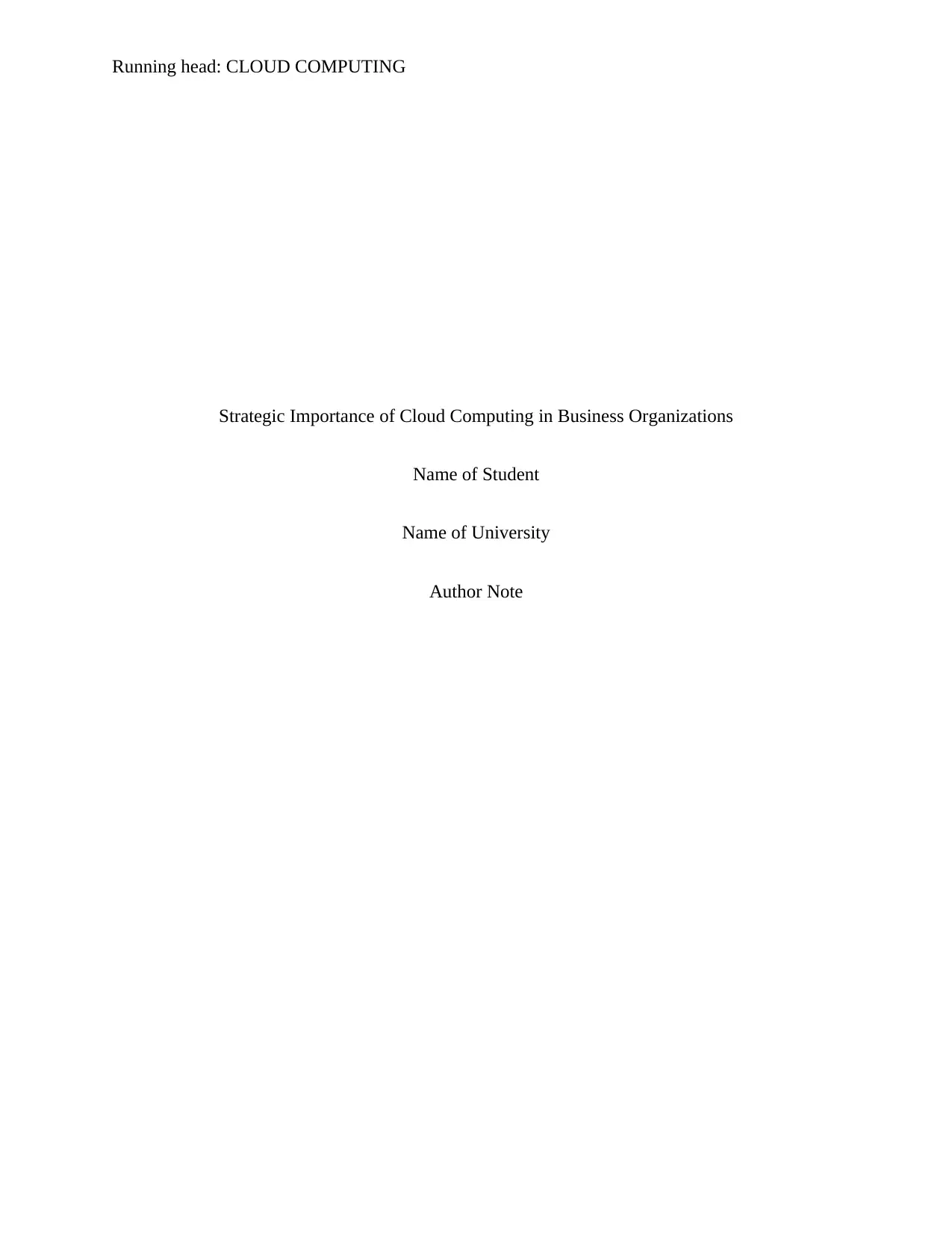
Running head: CLOUD COMPUTING
Strategic Importance of Cloud Computing in Business Organizations
Name of Student
Name of University
Author Note
Strategic Importance of Cloud Computing in Business Organizations
Name of Student
Name of University
Author Note
Paraphrase This Document
Need a fresh take? Get an instant paraphrase of this document with our AI Paraphraser
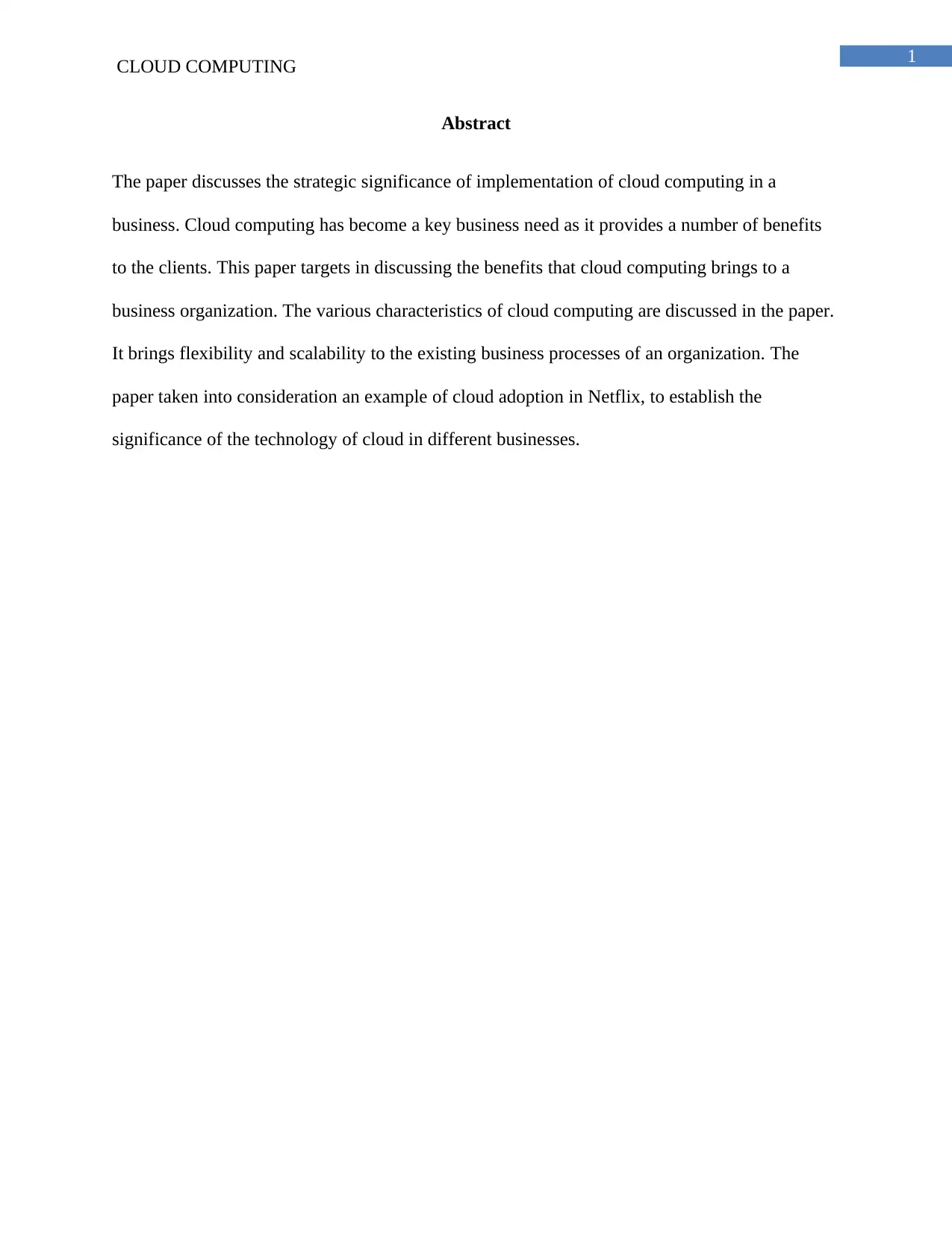
1
CLOUD COMPUTING
Abstract
The paper discusses the strategic significance of implementation of cloud computing in a
business. Cloud computing has become a key business need as it provides a number of benefits
to the clients. This paper targets in discussing the benefits that cloud computing brings to a
business organization. The various characteristics of cloud computing are discussed in the paper.
It brings flexibility and scalability to the existing business processes of an organization. The
paper taken into consideration an example of cloud adoption in Netflix, to establish the
significance of the technology of cloud in different businesses.
CLOUD COMPUTING
Abstract
The paper discusses the strategic significance of implementation of cloud computing in a
business. Cloud computing has become a key business need as it provides a number of benefits
to the clients. This paper targets in discussing the benefits that cloud computing brings to a
business organization. The various characteristics of cloud computing are discussed in the paper.
It brings flexibility and scalability to the existing business processes of an organization. The
paper taken into consideration an example of cloud adoption in Netflix, to establish the
significance of the technology of cloud in different businesses.
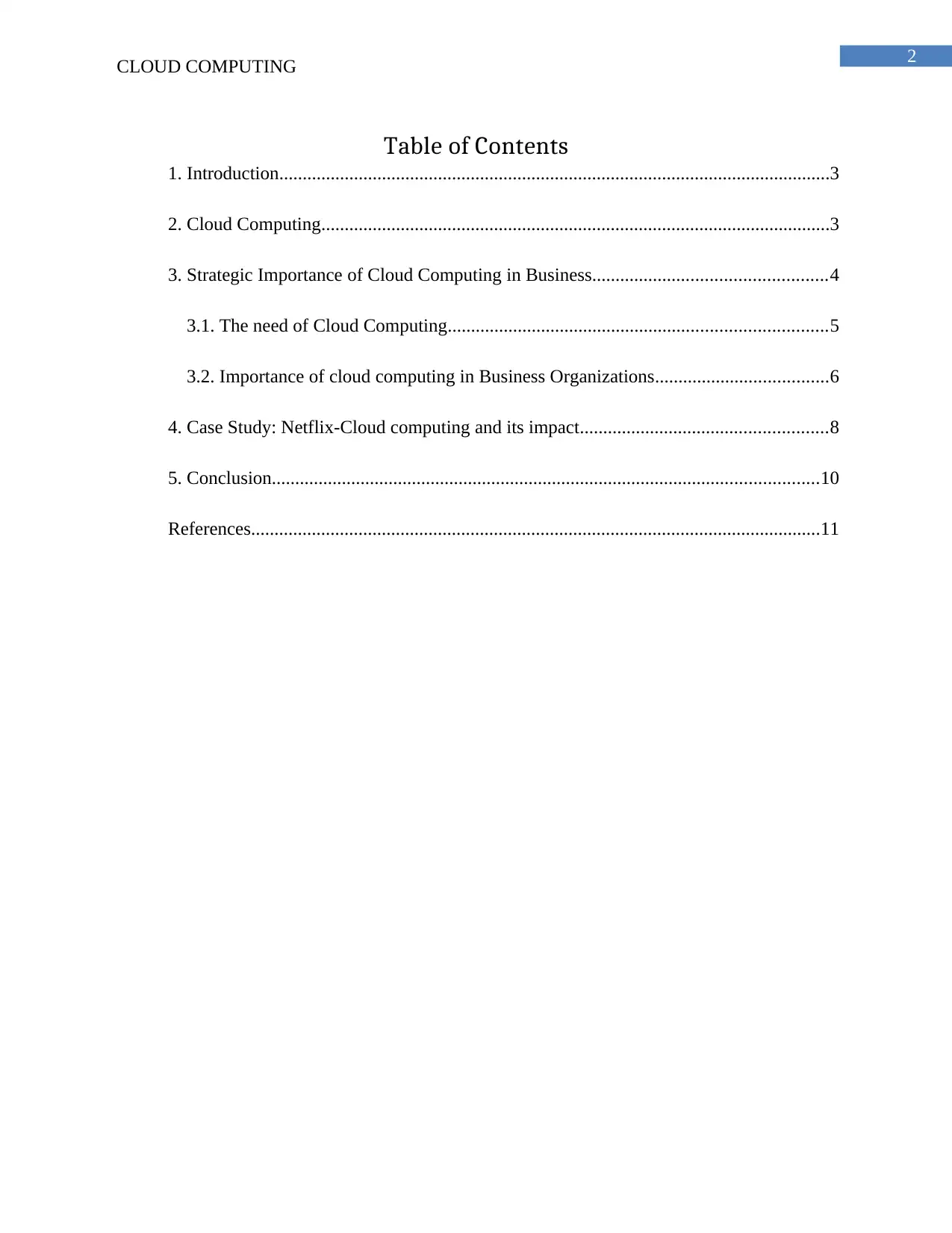
2
CLOUD COMPUTING
Table of Contents
1. Introduction......................................................................................................................3
2. Cloud Computing.............................................................................................................3
3. Strategic Importance of Cloud Computing in Business..................................................4
3.1. The need of Cloud Computing.................................................................................5
3.2. Importance of cloud computing in Business Organizations.....................................6
4. Case Study: Netflix-Cloud computing and its impact.....................................................8
5. Conclusion.....................................................................................................................10
References..........................................................................................................................11
CLOUD COMPUTING
Table of Contents
1. Introduction......................................................................................................................3
2. Cloud Computing.............................................................................................................3
3. Strategic Importance of Cloud Computing in Business..................................................4
3.1. The need of Cloud Computing.................................................................................5
3.2. Importance of cloud computing in Business Organizations.....................................6
4. Case Study: Netflix-Cloud computing and its impact.....................................................8
5. Conclusion.....................................................................................................................10
References..........................................................................................................................11
⊘ This is a preview!⊘
Do you want full access?
Subscribe today to unlock all pages.

Trusted by 1+ million students worldwide
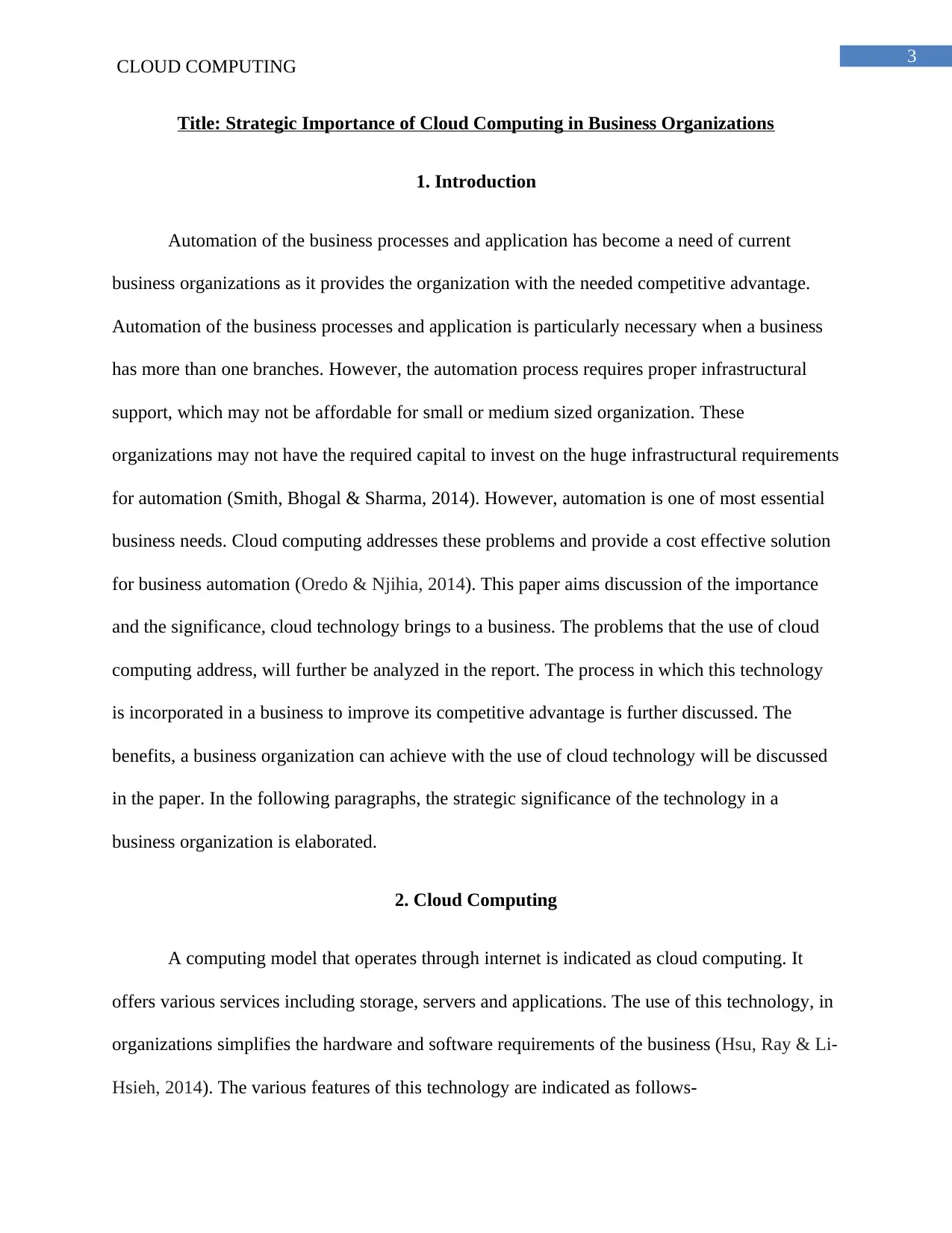
3
CLOUD COMPUTING
Title: Strategic Importance of Cloud Computing in Business Organizations
1. Introduction
Automation of the business processes and application has become a need of current
business organizations as it provides the organization with the needed competitive advantage.
Automation of the business processes and application is particularly necessary when a business
has more than one branches. However, the automation process requires proper infrastructural
support, which may not be affordable for small or medium sized organization. These
organizations may not have the required capital to invest on the huge infrastructural requirements
for automation (Smith, Bhogal & Sharma, 2014). However, automation is one of most essential
business needs. Cloud computing addresses these problems and provide a cost effective solution
for business automation (Oredo & Njihia, 2014). This paper aims discussion of the importance
and the significance, cloud technology brings to a business. The problems that the use of cloud
computing address, will further be analyzed in the report. The process in which this technology
is incorporated in a business to improve its competitive advantage is further discussed. The
benefits, a business organization can achieve with the use of cloud technology will be discussed
in the paper. In the following paragraphs, the strategic significance of the technology in a
business organization is elaborated.
2. Cloud Computing
A computing model that operates through internet is indicated as cloud computing. It
offers various services including storage, servers and applications. The use of this technology, in
organizations simplifies the hardware and software requirements of the business (Hsu, Ray & Li-
Hsieh, 2014). The various features of this technology are indicated as follows-
CLOUD COMPUTING
Title: Strategic Importance of Cloud Computing in Business Organizations
1. Introduction
Automation of the business processes and application has become a need of current
business organizations as it provides the organization with the needed competitive advantage.
Automation of the business processes and application is particularly necessary when a business
has more than one branches. However, the automation process requires proper infrastructural
support, which may not be affordable for small or medium sized organization. These
organizations may not have the required capital to invest on the huge infrastructural requirements
for automation (Smith, Bhogal & Sharma, 2014). However, automation is one of most essential
business needs. Cloud computing addresses these problems and provide a cost effective solution
for business automation (Oredo & Njihia, 2014). This paper aims discussion of the importance
and the significance, cloud technology brings to a business. The problems that the use of cloud
computing address, will further be analyzed in the report. The process in which this technology
is incorporated in a business to improve its competitive advantage is further discussed. The
benefits, a business organization can achieve with the use of cloud technology will be discussed
in the paper. In the following paragraphs, the strategic significance of the technology in a
business organization is elaborated.
2. Cloud Computing
A computing model that operates through internet is indicated as cloud computing. It
offers various services including storage, servers and applications. The use of this technology, in
organizations simplifies the hardware and software requirements of the business (Hsu, Ray & Li-
Hsieh, 2014). The various features of this technology are indicated as follows-
Paraphrase This Document
Need a fresh take? Get an instant paraphrase of this document with our AI Paraphraser
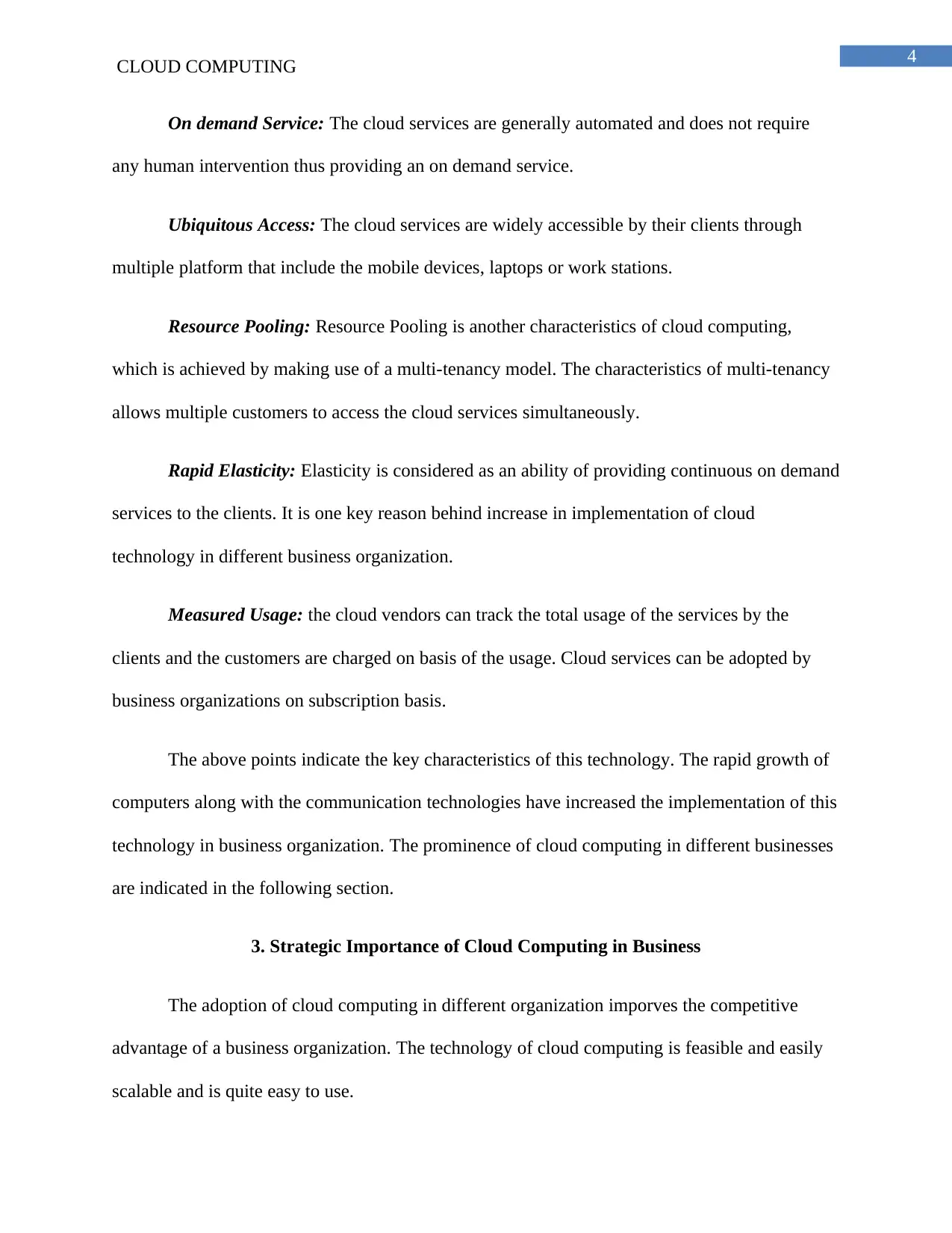
4
CLOUD COMPUTING
On demand Service: The cloud services are generally automated and does not require
any human intervention thus providing an on demand service.
Ubiquitous Access: The cloud services are widely accessible by their clients through
multiple platform that include the mobile devices, laptops or work stations.
Resource Pooling: Resource Pooling is another characteristics of cloud computing,
which is achieved by making use of a multi-tenancy model. The characteristics of multi-tenancy
allows multiple customers to access the cloud services simultaneously.
Rapid Elasticity: Elasticity is considered as an ability of providing continuous on demand
services to the clients. It is one key reason behind increase in implementation of cloud
technology in different business organization.
Measured Usage: the cloud vendors can track the total usage of the services by the
clients and the customers are charged on basis of the usage. Cloud services can be adopted by
business organizations on subscription basis.
The above points indicate the key characteristics of this technology. The rapid growth of
computers along with the communication technologies have increased the implementation of this
technology in business organization. The prominence of cloud computing in different businesses
are indicated in the following section.
3. Strategic Importance of Cloud Computing in Business
The adoption of cloud computing in different organization imporves the competitive
advantage of a business organization. The technology of cloud computing is feasible and easily
scalable and is quite easy to use.
CLOUD COMPUTING
On demand Service: The cloud services are generally automated and does not require
any human intervention thus providing an on demand service.
Ubiquitous Access: The cloud services are widely accessible by their clients through
multiple platform that include the mobile devices, laptops or work stations.
Resource Pooling: Resource Pooling is another characteristics of cloud computing,
which is achieved by making use of a multi-tenancy model. The characteristics of multi-tenancy
allows multiple customers to access the cloud services simultaneously.
Rapid Elasticity: Elasticity is considered as an ability of providing continuous on demand
services to the clients. It is one key reason behind increase in implementation of cloud
technology in different business organization.
Measured Usage: the cloud vendors can track the total usage of the services by the
clients and the customers are charged on basis of the usage. Cloud services can be adopted by
business organizations on subscription basis.
The above points indicate the key characteristics of this technology. The rapid growth of
computers along with the communication technologies have increased the implementation of this
technology in business organization. The prominence of cloud computing in different businesses
are indicated in the following section.
3. Strategic Importance of Cloud Computing in Business
The adoption of cloud computing in different organization imporves the competitive
advantage of a business organization. The technology of cloud computing is feasible and easily
scalable and is quite easy to use.
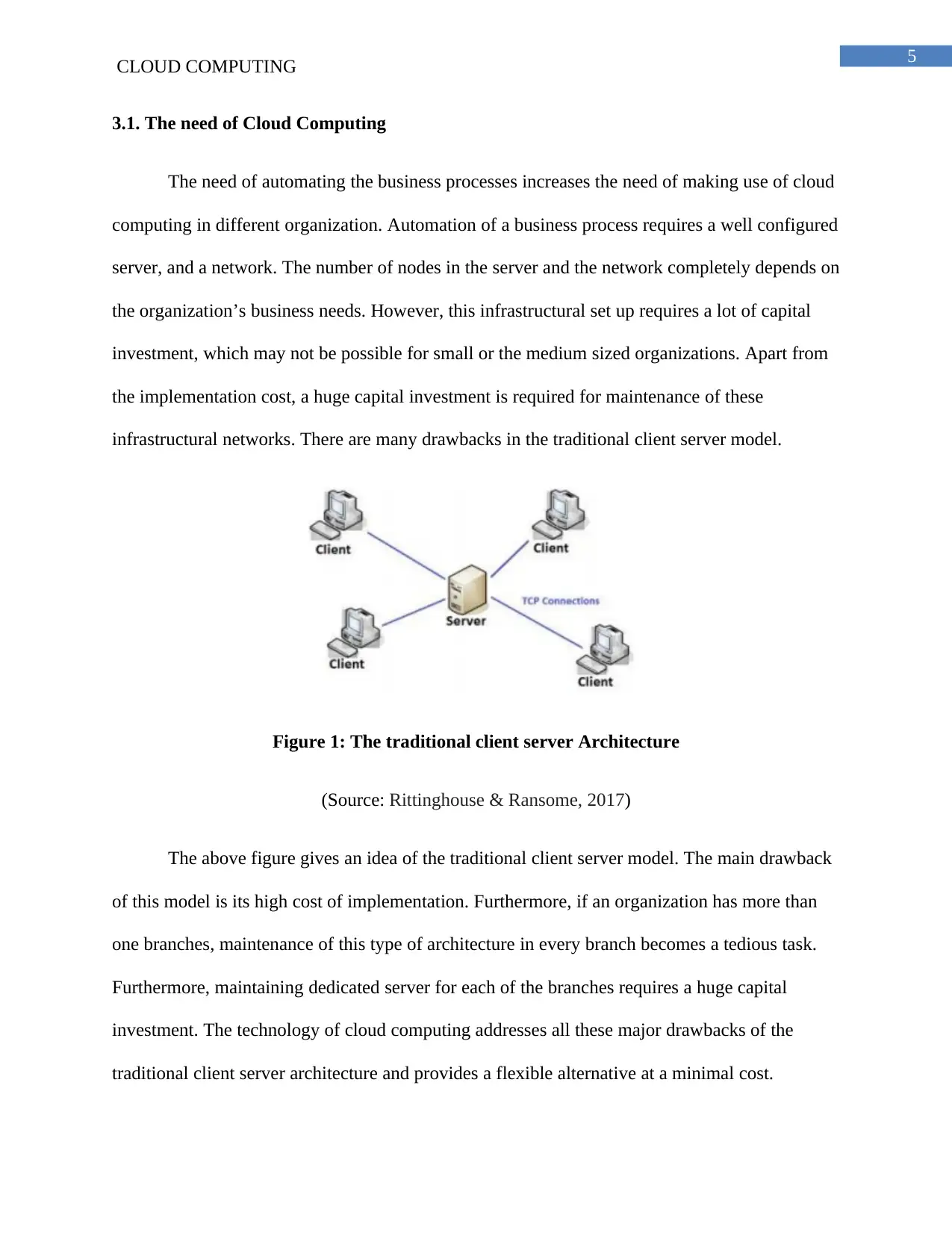
5
CLOUD COMPUTING
3.1. The need of Cloud Computing
The need of automating the business processes increases the need of making use of cloud
computing in different organization. Automation of a business process requires a well configured
server, and a network. The number of nodes in the server and the network completely depends on
the organization’s business needs. However, this infrastructural set up requires a lot of capital
investment, which may not be possible for small or the medium sized organizations. Apart from
the implementation cost, a huge capital investment is required for maintenance of these
infrastructural networks. There are many drawbacks in the traditional client server model.
Figure 1: The traditional client server Architecture
(Source: Rittinghouse & Ransome, 2017)
The above figure gives an idea of the traditional client server model. The main drawback
of this model is its high cost of implementation. Furthermore, if an organization has more than
one branches, maintenance of this type of architecture in every branch becomes a tedious task.
Furthermore, maintaining dedicated server for each of the branches requires a huge capital
investment. The technology of cloud computing addresses all these major drawbacks of the
traditional client server architecture and provides a flexible alternative at a minimal cost.
CLOUD COMPUTING
3.1. The need of Cloud Computing
The need of automating the business processes increases the need of making use of cloud
computing in different organization. Automation of a business process requires a well configured
server, and a network. The number of nodes in the server and the network completely depends on
the organization’s business needs. However, this infrastructural set up requires a lot of capital
investment, which may not be possible for small or the medium sized organizations. Apart from
the implementation cost, a huge capital investment is required for maintenance of these
infrastructural networks. There are many drawbacks in the traditional client server model.
Figure 1: The traditional client server Architecture
(Source: Rittinghouse & Ransome, 2017)
The above figure gives an idea of the traditional client server model. The main drawback
of this model is its high cost of implementation. Furthermore, if an organization has more than
one branches, maintenance of this type of architecture in every branch becomes a tedious task.
Furthermore, maintaining dedicated server for each of the branches requires a huge capital
investment. The technology of cloud computing addresses all these major drawbacks of the
traditional client server architecture and provides a flexible alternative at a minimal cost.
⊘ This is a preview!⊘
Do you want full access?
Subscribe today to unlock all pages.

Trusted by 1+ million students worldwide
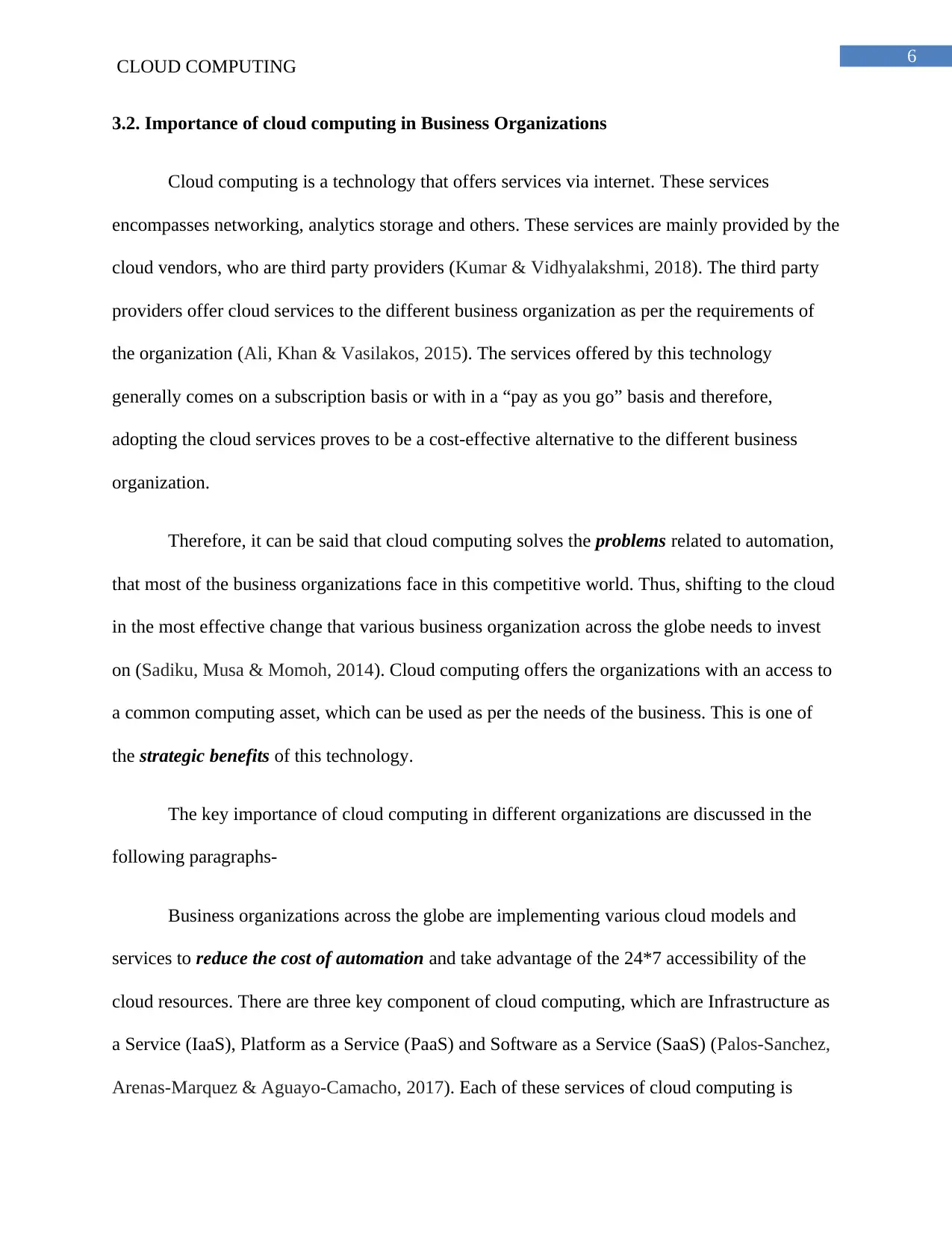
6
CLOUD COMPUTING
3.2. Importance of cloud computing in Business Organizations
Cloud computing is a technology that offers services via internet. These services
encompasses networking, analytics storage and others. These services are mainly provided by the
cloud vendors, who are third party providers (Kumar & Vidhyalakshmi, 2018). The third party
providers offer cloud services to the different business organization as per the requirements of
the organization (Ali, Khan & Vasilakos, 2015). The services offered by this technology
generally comes on a subscription basis or with in a “pay as you go” basis and therefore,
adopting the cloud services proves to be a cost-effective alternative to the different business
organization.
Therefore, it can be said that cloud computing solves the problems related to automation,
that most of the business organizations face in this competitive world. Thus, shifting to the cloud
in the most effective change that various business organization across the globe needs to invest
on (Sadiku, Musa & Momoh, 2014). Cloud computing offers the organizations with an access to
a common computing asset, which can be used as per the needs of the business. This is one of
the strategic benefits of this technology.
The key importance of cloud computing in different organizations are discussed in the
following paragraphs-
Business organizations across the globe are implementing various cloud models and
services to reduce the cost of automation and take advantage of the 24*7 accessibility of the
cloud resources. There are three key component of cloud computing, which are Infrastructure as
a Service (IaaS), Platform as a Service (PaaS) and Software as a Service (SaaS) (Palos-Sanchez,
Arenas-Marquez & Aguayo-Camacho, 2017). Each of these services of cloud computing is
CLOUD COMPUTING
3.2. Importance of cloud computing in Business Organizations
Cloud computing is a technology that offers services via internet. These services
encompasses networking, analytics storage and others. These services are mainly provided by the
cloud vendors, who are third party providers (Kumar & Vidhyalakshmi, 2018). The third party
providers offer cloud services to the different business organization as per the requirements of
the organization (Ali, Khan & Vasilakos, 2015). The services offered by this technology
generally comes on a subscription basis or with in a “pay as you go” basis and therefore,
adopting the cloud services proves to be a cost-effective alternative to the different business
organization.
Therefore, it can be said that cloud computing solves the problems related to automation,
that most of the business organizations face in this competitive world. Thus, shifting to the cloud
in the most effective change that various business organization across the globe needs to invest
on (Sadiku, Musa & Momoh, 2014). Cloud computing offers the organizations with an access to
a common computing asset, which can be used as per the needs of the business. This is one of
the strategic benefits of this technology.
The key importance of cloud computing in different organizations are discussed in the
following paragraphs-
Business organizations across the globe are implementing various cloud models and
services to reduce the cost of automation and take advantage of the 24*7 accessibility of the
cloud resources. There are three key component of cloud computing, which are Infrastructure as
a Service (IaaS), Platform as a Service (PaaS) and Software as a Service (SaaS) (Palos-Sanchez,
Arenas-Marquez & Aguayo-Camacho, 2017). Each of these services of cloud computing is
Paraphrase This Document
Need a fresh take? Get an instant paraphrase of this document with our AI Paraphraser
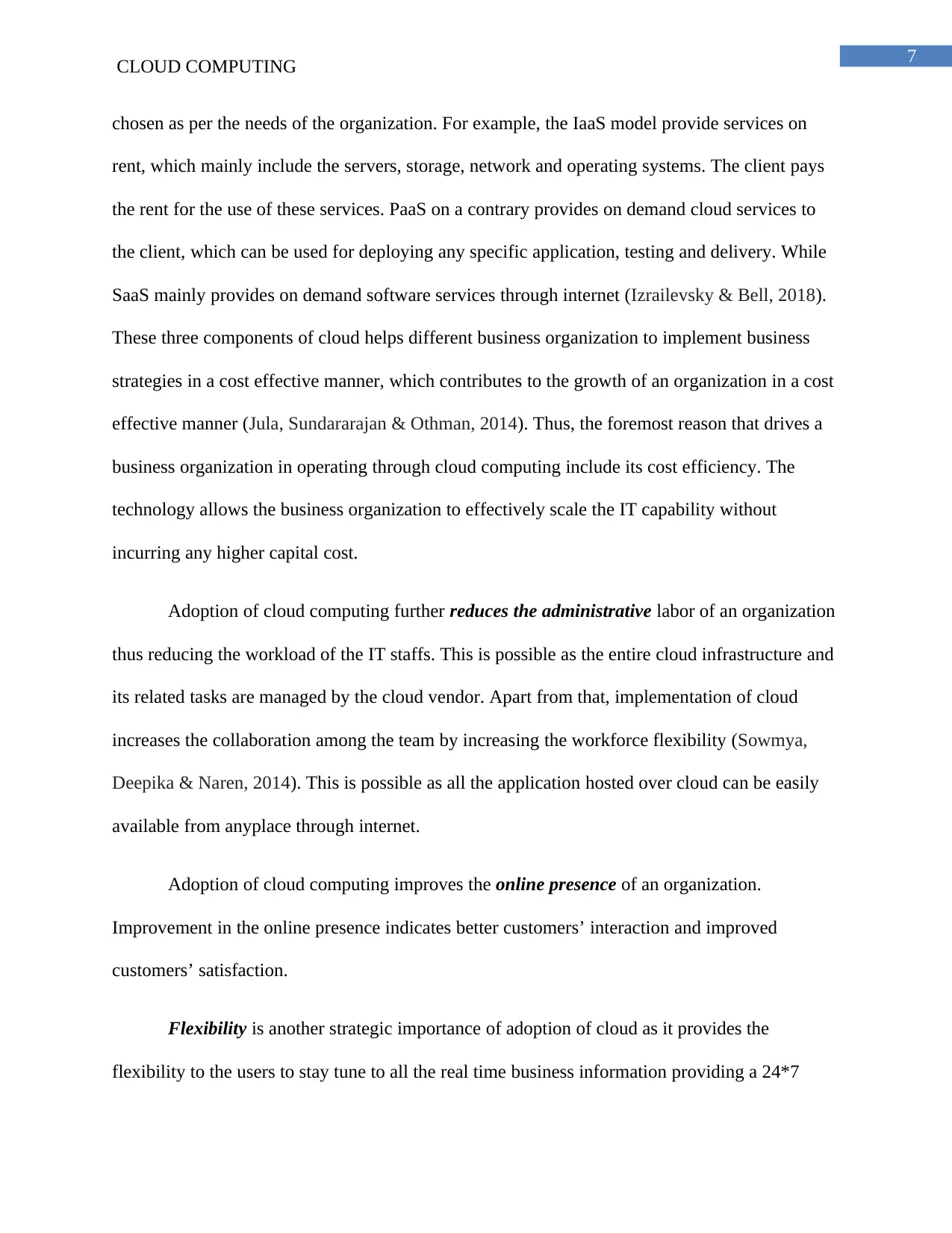
7
CLOUD COMPUTING
chosen as per the needs of the organization. For example, the IaaS model provide services on
rent, which mainly include the servers, storage, network and operating systems. The client pays
the rent for the use of these services. PaaS on a contrary provides on demand cloud services to
the client, which can be used for deploying any specific application, testing and delivery. While
SaaS mainly provides on demand software services through internet (Izrailevsky & Bell, 2018).
These three components of cloud helps different business organization to implement business
strategies in a cost effective manner, which contributes to the growth of an organization in a cost
effective manner (Jula, Sundararajan & Othman, 2014). Thus, the foremost reason that drives a
business organization in operating through cloud computing include its cost efficiency. The
technology allows the business organization to effectively scale the IT capability without
incurring any higher capital cost.
Adoption of cloud computing further reduces the administrative labor of an organization
thus reducing the workload of the IT staffs. This is possible as the entire cloud infrastructure and
its related tasks are managed by the cloud vendor. Apart from that, implementation of cloud
increases the collaboration among the team by increasing the workforce flexibility (Sowmya,
Deepika & Naren, 2014). This is possible as all the application hosted over cloud can be easily
available from anyplace through internet.
Adoption of cloud computing improves the online presence of an organization.
Improvement in the online presence indicates better customers’ interaction and improved
customers’ satisfaction.
Flexibility is another strategic importance of adoption of cloud as it provides the
flexibility to the users to stay tune to all the real time business information providing a 24*7
CLOUD COMPUTING
chosen as per the needs of the organization. For example, the IaaS model provide services on
rent, which mainly include the servers, storage, network and operating systems. The client pays
the rent for the use of these services. PaaS on a contrary provides on demand cloud services to
the client, which can be used for deploying any specific application, testing and delivery. While
SaaS mainly provides on demand software services through internet (Izrailevsky & Bell, 2018).
These three components of cloud helps different business organization to implement business
strategies in a cost effective manner, which contributes to the growth of an organization in a cost
effective manner (Jula, Sundararajan & Othman, 2014). Thus, the foremost reason that drives a
business organization in operating through cloud computing include its cost efficiency. The
technology allows the business organization to effectively scale the IT capability without
incurring any higher capital cost.
Adoption of cloud computing further reduces the administrative labor of an organization
thus reducing the workload of the IT staffs. This is possible as the entire cloud infrastructure and
its related tasks are managed by the cloud vendor. Apart from that, implementation of cloud
increases the collaboration among the team by increasing the workforce flexibility (Sowmya,
Deepika & Naren, 2014). This is possible as all the application hosted over cloud can be easily
available from anyplace through internet.
Adoption of cloud computing improves the online presence of an organization.
Improvement in the online presence indicates better customers’ interaction and improved
customers’ satisfaction.
Flexibility is another strategic importance of adoption of cloud as it provides the
flexibility to the users to stay tune to all the real time business information providing a 24*7
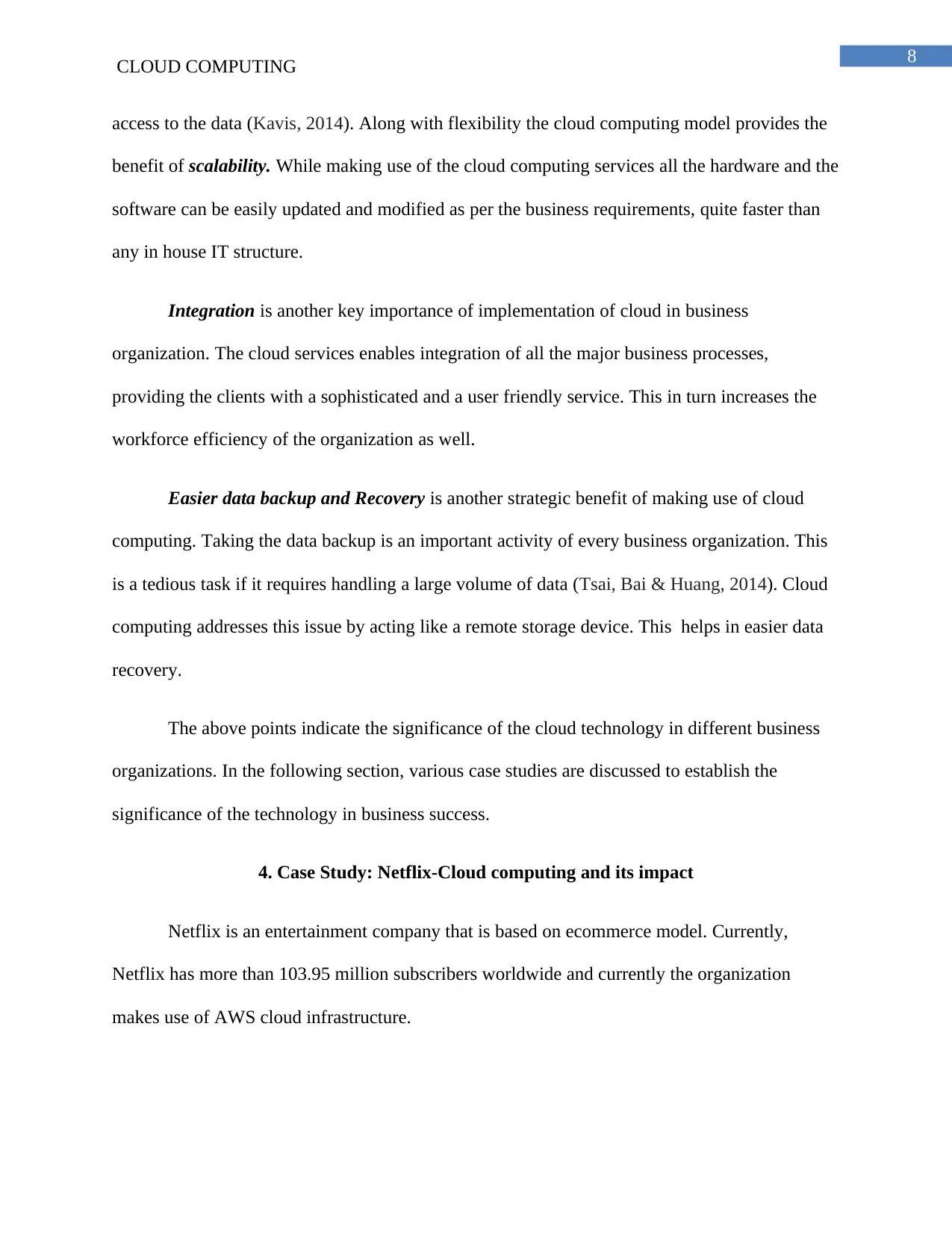
8
CLOUD COMPUTING
access to the data (Kavis, 2014). Along with flexibility the cloud computing model provides the
benefit of scalability. While making use of the cloud computing services all the hardware and the
software can be easily updated and modified as per the business requirements, quite faster than
any in house IT structure.
Integration is another key importance of implementation of cloud in business
organization. The cloud services enables integration of all the major business processes,
providing the clients with a sophisticated and a user friendly service. This in turn increases the
workforce efficiency of the organization as well.
Easier data backup and Recovery is another strategic benefit of making use of cloud
computing. Taking the data backup is an important activity of every business organization. This
is a tedious task if it requires handling a large volume of data (Tsai, Bai & Huang, 2014). Cloud
computing addresses this issue by acting like a remote storage device. This helps in easier data
recovery.
The above points indicate the significance of the cloud technology in different business
organizations. In the following section, various case studies are discussed to establish the
significance of the technology in business success.
4. Case Study: Netflix-Cloud computing and its impact
Netflix is an entertainment company that is based on ecommerce model. Currently,
Netflix has more than 103.95 million subscribers worldwide and currently the organization
makes use of AWS cloud infrastructure.
CLOUD COMPUTING
access to the data (Kavis, 2014). Along with flexibility the cloud computing model provides the
benefit of scalability. While making use of the cloud computing services all the hardware and the
software can be easily updated and modified as per the business requirements, quite faster than
any in house IT structure.
Integration is another key importance of implementation of cloud in business
organization. The cloud services enables integration of all the major business processes,
providing the clients with a sophisticated and a user friendly service. This in turn increases the
workforce efficiency of the organization as well.
Easier data backup and Recovery is another strategic benefit of making use of cloud
computing. Taking the data backup is an important activity of every business organization. This
is a tedious task if it requires handling a large volume of data (Tsai, Bai & Huang, 2014). Cloud
computing addresses this issue by acting like a remote storage device. This helps in easier data
recovery.
The above points indicate the significance of the cloud technology in different business
organizations. In the following section, various case studies are discussed to establish the
significance of the technology in business success.
4. Case Study: Netflix-Cloud computing and its impact
Netflix is an entertainment company that is based on ecommerce model. Currently,
Netflix has more than 103.95 million subscribers worldwide and currently the organization
makes use of AWS cloud infrastructure.
⊘ This is a preview!⊘
Do you want full access?
Subscribe today to unlock all pages.

Trusted by 1+ million students worldwide
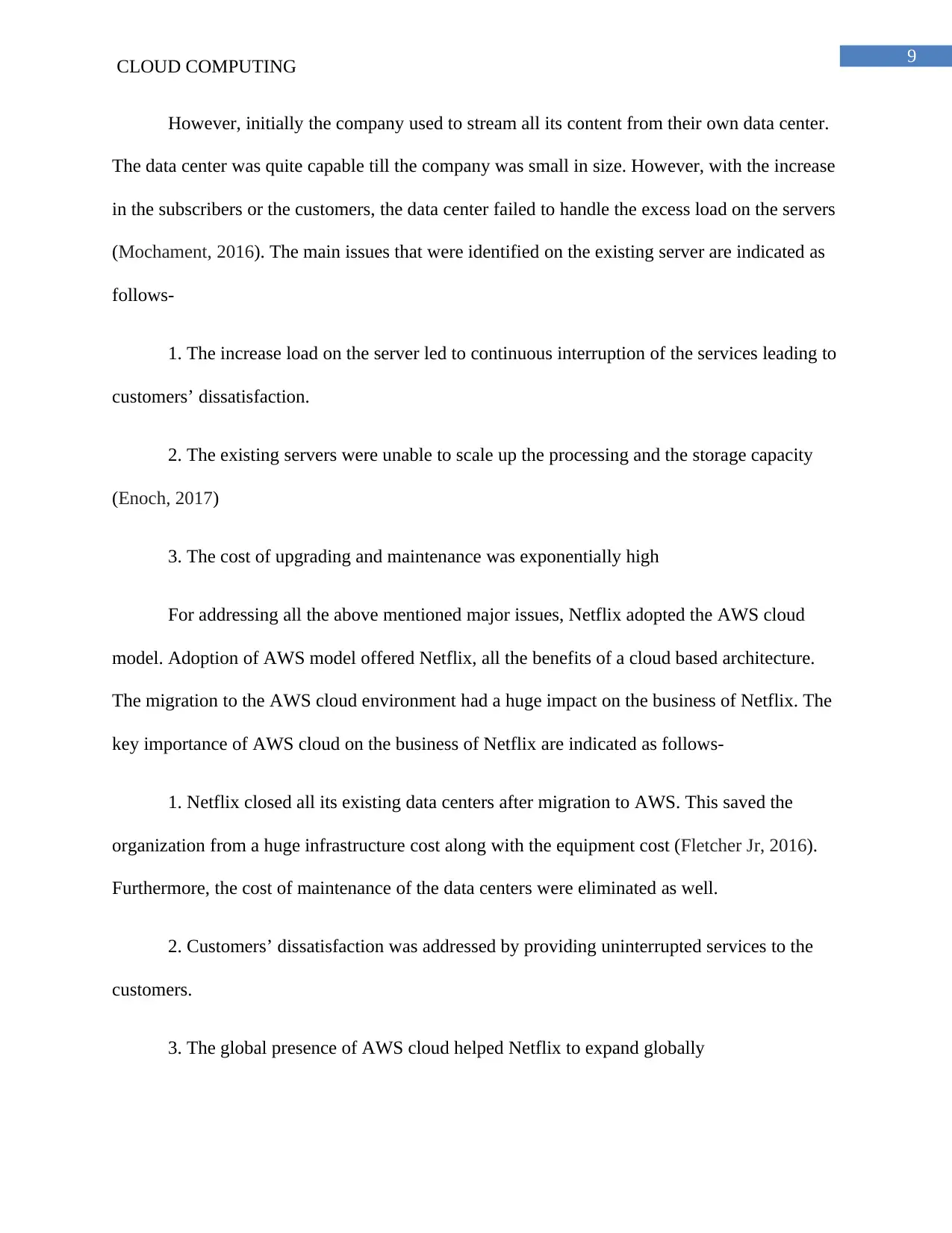
9
CLOUD COMPUTING
However, initially the company used to stream all its content from their own data center.
The data center was quite capable till the company was small in size. However, with the increase
in the subscribers or the customers, the data center failed to handle the excess load on the servers
(Mochament, 2016). The main issues that were identified on the existing server are indicated as
follows-
1. The increase load on the server led to continuous interruption of the services leading to
customers’ dissatisfaction.
2. The existing servers were unable to scale up the processing and the storage capacity
(Enoch, 2017)
3. The cost of upgrading and maintenance was exponentially high
For addressing all the above mentioned major issues, Netflix adopted the AWS cloud
model. Adoption of AWS model offered Netflix, all the benefits of a cloud based architecture.
The migration to the AWS cloud environment had a huge impact on the business of Netflix. The
key importance of AWS cloud on the business of Netflix are indicated as follows-
1. Netflix closed all its existing data centers after migration to AWS. This saved the
organization from a huge infrastructure cost along with the equipment cost (Fletcher Jr, 2016).
Furthermore, the cost of maintenance of the data centers were eliminated as well.
2. Customers’ dissatisfaction was addressed by providing uninterrupted services to the
customers.
3. The global presence of AWS cloud helped Netflix to expand globally
CLOUD COMPUTING
However, initially the company used to stream all its content from their own data center.
The data center was quite capable till the company was small in size. However, with the increase
in the subscribers or the customers, the data center failed to handle the excess load on the servers
(Mochament, 2016). The main issues that were identified on the existing server are indicated as
follows-
1. The increase load on the server led to continuous interruption of the services leading to
customers’ dissatisfaction.
2. The existing servers were unable to scale up the processing and the storage capacity
(Enoch, 2017)
3. The cost of upgrading and maintenance was exponentially high
For addressing all the above mentioned major issues, Netflix adopted the AWS cloud
model. Adoption of AWS model offered Netflix, all the benefits of a cloud based architecture.
The migration to the AWS cloud environment had a huge impact on the business of Netflix. The
key importance of AWS cloud on the business of Netflix are indicated as follows-
1. Netflix closed all its existing data centers after migration to AWS. This saved the
organization from a huge infrastructure cost along with the equipment cost (Fletcher Jr, 2016).
Furthermore, the cost of maintenance of the data centers were eliminated as well.
2. Customers’ dissatisfaction was addressed by providing uninterrupted services to the
customers.
3. The global presence of AWS cloud helped Netflix to expand globally
Paraphrase This Document
Need a fresh take? Get an instant paraphrase of this document with our AI Paraphraser
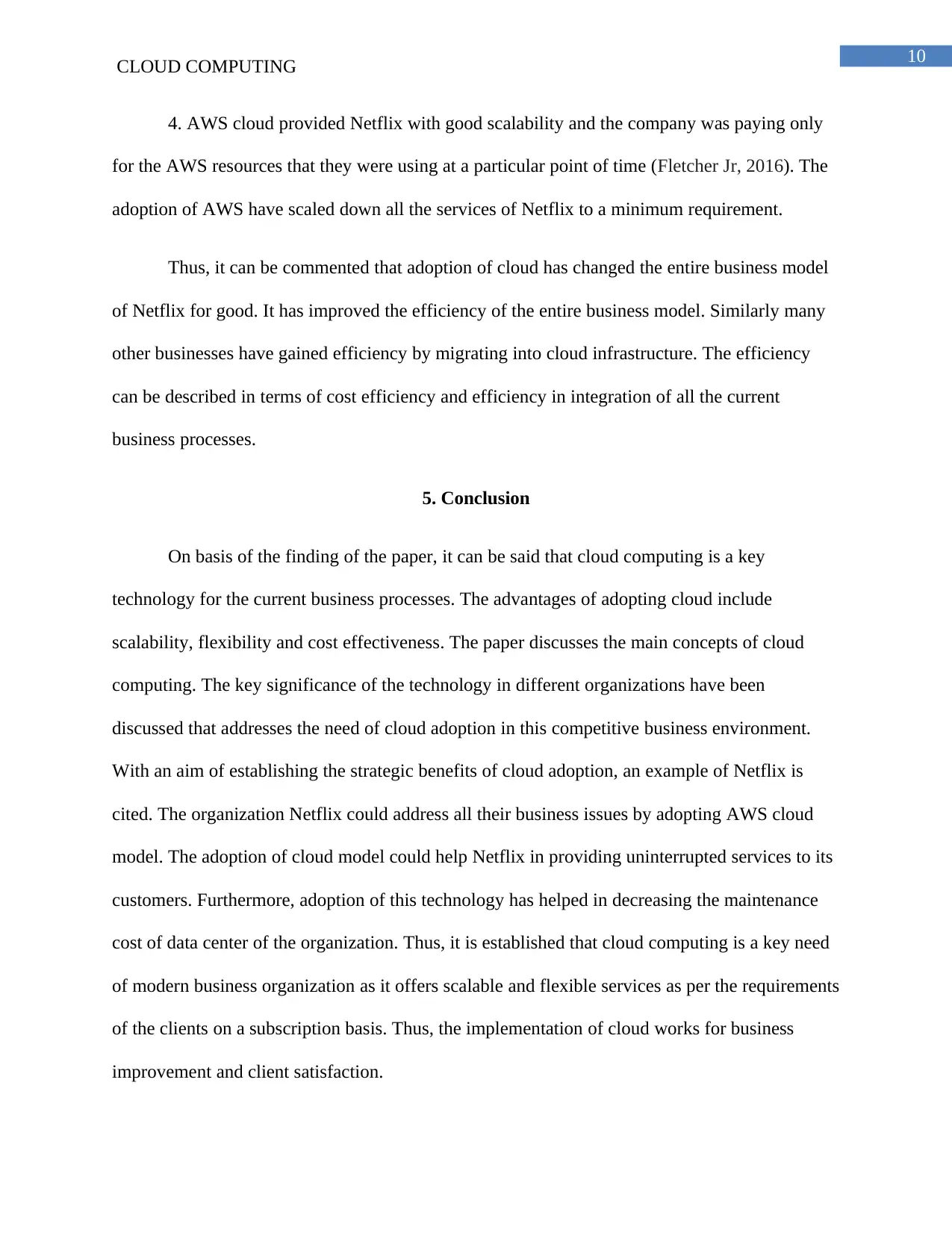
10
CLOUD COMPUTING
4. AWS cloud provided Netflix with good scalability and the company was paying only
for the AWS resources that they were using at a particular point of time (Fletcher Jr, 2016). The
adoption of AWS have scaled down all the services of Netflix to a minimum requirement.
Thus, it can be commented that adoption of cloud has changed the entire business model
of Netflix for good. It has improved the efficiency of the entire business model. Similarly many
other businesses have gained efficiency by migrating into cloud infrastructure. The efficiency
can be described in terms of cost efficiency and efficiency in integration of all the current
business processes.
5. Conclusion
On basis of the finding of the paper, it can be said that cloud computing is a key
technology for the current business processes. The advantages of adopting cloud include
scalability, flexibility and cost effectiveness. The paper discusses the main concepts of cloud
computing. The key significance of the technology in different organizations have been
discussed that addresses the need of cloud adoption in this competitive business environment.
With an aim of establishing the strategic benefits of cloud adoption, an example of Netflix is
cited. The organization Netflix could address all their business issues by adopting AWS cloud
model. The adoption of cloud model could help Netflix in providing uninterrupted services to its
customers. Furthermore, adoption of this technology has helped in decreasing the maintenance
cost of data center of the organization. Thus, it is established that cloud computing is a key need
of modern business organization as it offers scalable and flexible services as per the requirements
of the clients on a subscription basis. Thus, the implementation of cloud works for business
improvement and client satisfaction.
CLOUD COMPUTING
4. AWS cloud provided Netflix with good scalability and the company was paying only
for the AWS resources that they were using at a particular point of time (Fletcher Jr, 2016). The
adoption of AWS have scaled down all the services of Netflix to a minimum requirement.
Thus, it can be commented that adoption of cloud has changed the entire business model
of Netflix for good. It has improved the efficiency of the entire business model. Similarly many
other businesses have gained efficiency by migrating into cloud infrastructure. The efficiency
can be described in terms of cost efficiency and efficiency in integration of all the current
business processes.
5. Conclusion
On basis of the finding of the paper, it can be said that cloud computing is a key
technology for the current business processes. The advantages of adopting cloud include
scalability, flexibility and cost effectiveness. The paper discusses the main concepts of cloud
computing. The key significance of the technology in different organizations have been
discussed that addresses the need of cloud adoption in this competitive business environment.
With an aim of establishing the strategic benefits of cloud adoption, an example of Netflix is
cited. The organization Netflix could address all their business issues by adopting AWS cloud
model. The adoption of cloud model could help Netflix in providing uninterrupted services to its
customers. Furthermore, adoption of this technology has helped in decreasing the maintenance
cost of data center of the organization. Thus, it is established that cloud computing is a key need
of modern business organization as it offers scalable and flexible services as per the requirements
of the clients on a subscription basis. Thus, the implementation of cloud works for business
improvement and client satisfaction.
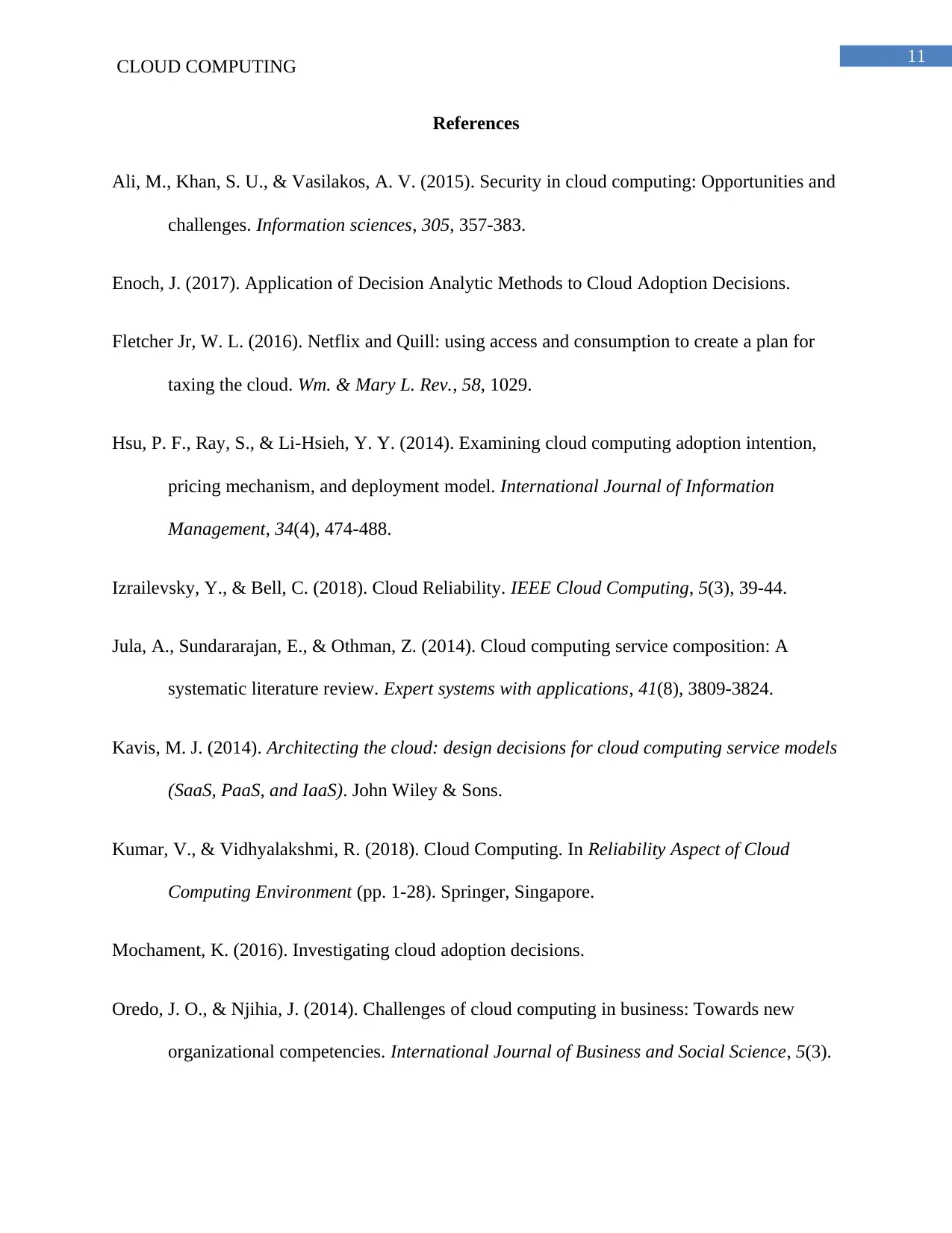
11
CLOUD COMPUTING
References
Ali, M., Khan, S. U., & Vasilakos, A. V. (2015). Security in cloud computing: Opportunities and
challenges. Information sciences, 305, 357-383.
Enoch, J. (2017). Application of Decision Analytic Methods to Cloud Adoption Decisions.
Fletcher Jr, W. L. (2016). Netflix and Quill: using access and consumption to create a plan for
taxing the cloud. Wm. & Mary L. Rev., 58, 1029.
Hsu, P. F., Ray, S., & Li-Hsieh, Y. Y. (2014). Examining cloud computing adoption intention,
pricing mechanism, and deployment model. International Journal of Information
Management, 34(4), 474-488.
Izrailevsky, Y., & Bell, C. (2018). Cloud Reliability. IEEE Cloud Computing, 5(3), 39-44.
Jula, A., Sundararajan, E., & Othman, Z. (2014). Cloud computing service composition: A
systematic literature review. Expert systems with applications, 41(8), 3809-3824.
Kavis, M. J. (2014). Architecting the cloud: design decisions for cloud computing service models
(SaaS, PaaS, and IaaS). John Wiley & Sons.
Kumar, V., & Vidhyalakshmi, R. (2018). Cloud Computing. In Reliability Aspect of Cloud
Computing Environment (pp. 1-28). Springer, Singapore.
Mochament, K. (2016). Investigating cloud adoption decisions.
Oredo, J. O., & Njihia, J. (2014). Challenges of cloud computing in business: Towards new
organizational competencies. International Journal of Business and Social Science, 5(3).
CLOUD COMPUTING
References
Ali, M., Khan, S. U., & Vasilakos, A. V. (2015). Security in cloud computing: Opportunities and
challenges. Information sciences, 305, 357-383.
Enoch, J. (2017). Application of Decision Analytic Methods to Cloud Adoption Decisions.
Fletcher Jr, W. L. (2016). Netflix and Quill: using access and consumption to create a plan for
taxing the cloud. Wm. & Mary L. Rev., 58, 1029.
Hsu, P. F., Ray, S., & Li-Hsieh, Y. Y. (2014). Examining cloud computing adoption intention,
pricing mechanism, and deployment model. International Journal of Information
Management, 34(4), 474-488.
Izrailevsky, Y., & Bell, C. (2018). Cloud Reliability. IEEE Cloud Computing, 5(3), 39-44.
Jula, A., Sundararajan, E., & Othman, Z. (2014). Cloud computing service composition: A
systematic literature review. Expert systems with applications, 41(8), 3809-3824.
Kavis, M. J. (2014). Architecting the cloud: design decisions for cloud computing service models
(SaaS, PaaS, and IaaS). John Wiley & Sons.
Kumar, V., & Vidhyalakshmi, R. (2018). Cloud Computing. In Reliability Aspect of Cloud
Computing Environment (pp. 1-28). Springer, Singapore.
Mochament, K. (2016). Investigating cloud adoption decisions.
Oredo, J. O., & Njihia, J. (2014). Challenges of cloud computing in business: Towards new
organizational competencies. International Journal of Business and Social Science, 5(3).
⊘ This is a preview!⊘
Do you want full access?
Subscribe today to unlock all pages.

Trusted by 1+ million students worldwide
1 out of 13
Related Documents
Your All-in-One AI-Powered Toolkit for Academic Success.
+13062052269
info@desklib.com
Available 24*7 on WhatsApp / Email
![[object Object]](/_next/static/media/star-bottom.7253800d.svg)
Unlock your academic potential
Copyright © 2020–2025 A2Z Services. All Rights Reserved. Developed and managed by ZUCOL.




